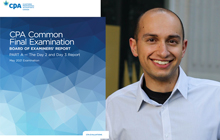Planning for PER: Writing the CPA practical experience requirements reports (Part 1)

CPA program coach Gevorg Grigoryan, CPA on why it's important to plan ahead
VANCOUVER – After passing the CPA program's Common Final Examination (CFE), candidates conquer a major milestone towards becoming a Canadian accountant. The CFE marks the completion of a long and challenging journey, but some candidates have to wait several months before they can apply for their chartered professional accountant (CPA) designation. The reason? The practical experience requirements.
To earn the CPA designation, candidates must complete the CPA Practical Experience Requirements (PER), in addition to passing the six modules and the CFE. To complete PER, candidates must gain a minimum of 30 months (24 months in Quebec) of relevant experience and write several experience reports. As some of my students have put it, writing the experience reports is as challenging as passing the CFE, requiring 20 to 40 hours of writing time and strict reporting formats.
To help you with the process, the following is my five-step approach to successfully writing PER reports, as part one of a two-part series.
Step 1: Get access to PERT
CPA Canada’s online practical experience reporting tool (PERT) is the platform that you will use to write the details and duration of your experience. In Quebec, you’ll use a similar platform called “PERL.” You gain access to PERT/PERL when you start PEP, in other words, when you start the Core 1 module. A major mistake I see in candidates is that they neglect the PER reporting and focus only on studies. Although Core 1 and Core 2 are both demanding, delaying your PER reporting will penalize you and grow into a major bottleneck when you get close to CFE. I suggest building a schedule and allocating at least 3 hours per month on writing your PER examples.
Step 2: Find a PER mentor
In PER, you need both a supervisor and a mentor. The supervisor is the person you report to at your work and they don't have to be a CPA. They ensure your experience reports are accurate. The mentor can be anyone, from any province in Canada, as long as they are a CPA in good standing. In Quebec, you must first attempt to find a CPA mentor within your current place of employment before looking externally. Mentors help you develop your competencies through ongoing meetings. A challenge that you’ll face here is finding a mentor. Here are some tips to help you find a PER mentor:
- Make your supervisor your mentor. Speak with your supervisor and ask them if they are open to mentoring you. The advantage is that you don't have to schedule two separate meetings, you can take care of the mentor meeting while meeting your supervisor. Just make sure your supervisor is a CPA in good standing as this is one of the requirements.
- Use the Mentor Match Portal. CPA Canada's Mentor Match Portal provides a listing of available mentors. Go through the profiles and request to connect with mentors who meet your needs.
- Ask a manager of another finance department in your company. If you work in a big company where there are multiple finance functions, and your direct supervisor is ineligible to mentor you, ask a manager from another department.
- Look for someone in your network through LinkedIn. This is convenient as you can see in their profile whether they have CPA mentoring experience, thus more likely to accept you.
- Go to CPA Canada networking events and to meet a mentor. The networking events are hosted several times a year and they are free to attend.
Step 3: Send a pre-assessment
Pre-assessment means sending your job description to the PER team so that they can confirm your position is relevant and counts towards the PER requirements. Candidates often get nervous about their job title, believing that a junior or clerical title will not qualify. This is only a myth, whether your title is AP clerk or Junior accountant, PER reviewers are looking for you to have minimal experience with the current title. They understand that over the 30-months of reporting, your responsibilities will change and you will progress towards more senior tasks. I suggest using PER’s Self-Assessment tool to check whether your current role qualifies and submitting the pre-assessment as soon as you can.
Step 4. Report prior experience
Prior experience is any work experience before your PER start date, in other words, when you get access to PERT and secure a mentor. You can rollover a maximum of 12 months (8 months in Quebec) and minimum of three months of prior experience. This is helpful because you can reduce your 30-month requirement by rolling over your prior experience. If you were working before you started PEP, I strongly suggest that you report this experience, as it will help you save time and give you CPA faster.
Step 5: Report current experience
Once you've completed the above steps, it's time to write and submit your current experience. In part two of this two-part series, you’ll find helpful tips and examples on writing CPA Canada PER reports, as your journey continues to becoming a Canadian accountant.
Gevorg Grigoryan, CPA, is an instructor, mentor and coach to students in the CPA program. Visit Gevorg CPA to learn more and subscribe to Gevorg’s YouTube channel to access CPA program videos.









(0) Comments